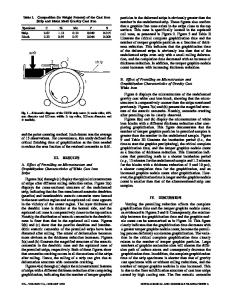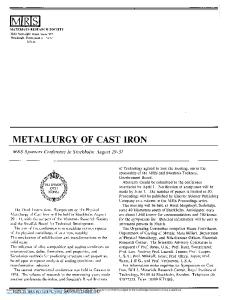Enhanced densification of white cast iron powders by cyclic phase transformations under stress
- PDF / 2,070,969 Bytes
- 7 Pages / 594 x 774 pts Page_size
- 61 Downloads / 335 Views
I.
INTRODUCTION
THEadvent of new technologies centered on rapidly solidified powders often requires development of methods of enhancing densification wherein the fine structures present in such powders are retained. To achieve this goal it is necessary to use low temperatures, but this usually requires the application of high pressures if a high density is to be achieved. High pressures are often a limiting factor in the manufacture of powder products. Methods which permit the reduction of pressure needed for high densification are therefore desirable. One such method of enhancing densification of powders is by accelerating plastic flow through the generation of internal stresses during warm pressing. A technique for generating intemal stress is through the use of multiple, solid-state phase transformations (transformation superplasticity). 1-5 A number of investigations have utilized multiple phase transformations as a possible means of enhancing sintering of powders. 6'7'8 Little or no significant enhancement in densification was reported in these cases where no applied stresses were used. Kohara 9 extended this work by investigating the densificatien ef hon powders through transformation cycling under extremely small applied stresses ( - 0.1 MPa (10 psi)). The enhancement of densification observed by Kohara, although limited, was attributed to the occurrence of transformation superplasticity. In a separate investigation. Oshida ~~ examined the densification of cast iron powders by multiple thermal cycling through the A I transformation temperature (727 ~ under small applied stresses (0.5 to 1.5 MPa (70 to 210 psi)), and he also attributed the enhancement of densification to transformation superplasticity. The densification observed by Kohara and by Oshida, however, cannot be attributed to transformation superplasticity. As will be shown in the next section, under the transformation cycling conditions used by these investigators, significant densification would be expected only if OSCAR A. RUANO and JEFFREY WADSWORTH. both formerly with the Department of Materials Science and Engineenng, Stanford University, are now. respectively, Research Scientist. CENIM. Av. de Gregorio del Amo s/n. Madrid (3). Spain, and Research Scientist, Lockheed Research Laboratory, Palo Alto. CA 94305. OLEG D. SHERBY is Professor of Materials Science and Engineering, Stanford University, Stanford. CA 94305. Manuscript submitted June 19. 1981. METALLURGICAL TRANSACTIONS A
9
stresses much above 1.5 MPa hadbeen applied. The above discussion would indicate that the influence of transformation superplasticity on densification of powders has not been resolved. It is the purpose of this paper to examine this area with two objectives in mind. The first is to investigate the possibility of enhancing the densification, by multiple phase transformations, of 2.4 pct C white cast iron powders manufactured by rapid solidification rate processing. The object in this case is to establish the influence of transformation superplasticity over a wide ra











